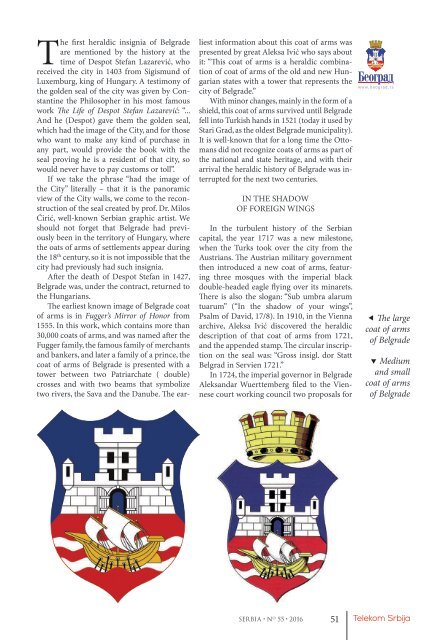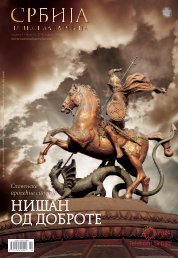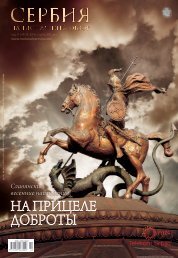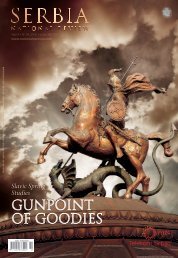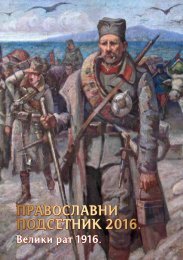Srbija - nacionalna revija - broj 55 - engleski - niska rezolucija
You also want an ePaper? Increase the reach of your titles
YUMPU automatically turns print PDFs into web optimized ePapers that Google loves.
The first heraldic insignia of Belgrade<br />
are mentioned by the history at the<br />
time of Despot Stefan Lazarević, who<br />
received the city in 1403 from Sigismund of<br />
Luxemburg, king of Hungary. A testimony of<br />
the golden seal of the city was given by Constantine<br />
the Philosopher in his most famous<br />
work The Life of Despot Stefan Lazarević: “...<br />
And he (Despot) gave them the golden seal,<br />
which had the image of the City, and for those<br />
who want to make any kind of purchase in<br />
any part, would provide the book with the<br />
seal proving he is a resident of that city, so<br />
would never have to pay customs or toll”.<br />
If we take the phrase “had the image of<br />
the City” literally – that it is the panoramic<br />
view of the City walls, we come to the reconstruction<br />
of the seal created by prof. Dr. Milos<br />
Ćirić, well-known Serbian graphic artist. We<br />
should not forget that Belgrade had previously<br />
been in the territory of Hungary, where<br />
the oats of arms of settlements appear during<br />
the 18 th century, so it is not impossible that the<br />
city had previously had such insignia.<br />
After the death of Despot Stefan in 1427,<br />
Belgrade was, under the contract, returned to<br />
the Hungarians.<br />
The earliest known image of Belgrade coat<br />
of arms is in Fugger’s Mirror of Honor from<br />
1<strong>55</strong>5. In this work, which contains more than<br />
30,000 coats of arms, and was named after the<br />
Fugger family, the famous family of merchants<br />
and bankers, and later a family of a prince, the<br />
coat of arms of Belgrade is presented with a<br />
tower between two Patriarchate ( double)<br />
crosses and with two beams that symbolize<br />
two rivers, the Sava and the Danube. The earliest<br />
information about this coat of arms was<br />
presented by great Aleksa Ivić who says about<br />
it: “This coat of arms is a heraldic combination<br />
of coat of arms of the old and new Hungarian<br />
states with a tower that represents the<br />
city of Belgrade.”<br />
With minor changes, mainly in the form of a<br />
shield, this coat of arms survived until Belgrade<br />
fell into Turkish hands in 1521 (today it used by<br />
Stari Grad, as the oldest Belgrade municipality).<br />
It is well-known that for a long time the Ottomans<br />
did not recognize coats of arms as part of<br />
the national and state heritage, and with their<br />
arrival the heraldic history of Belgrade was interrupted<br />
for the next two centuries.<br />
IN THE SHADOW<br />
OF FOREIGN WINGS<br />
In the turbulent history of the Serbian<br />
capital, the year 1717 was a new milestone,<br />
when the Turks took over the city from the<br />
Austrians. The Austrian military government<br />
then introduced a new coat of arms, featuring<br />
three mosques with the imperial black<br />
double-headed eagle flying over its minarets.<br />
There is also the slogan: “Sub umbra alarum<br />
tuarum” (“In the shadow of your wings”,<br />
Psalm of David, 17/8). In 1910, in the Vienna<br />
archive, Aleksa Ivić discovered the heraldic<br />
description of that coat of arms from 1721,<br />
and the appended stamp. The circular inscription<br />
on the seal was: “Gross insigl. dor Statt<br />
Belgrad in Servien 1721.”<br />
In 1724, the imperial governor in Belgrade<br />
Aleksandar Wuerttemberg filed to the Viennese<br />
court working council two proposals for<br />
The large<br />
coat of arms<br />
of Belgrade<br />
Medium<br />
and small<br />
coat of arms<br />
of Belgrade<br />
SERBIA • N O <strong>55</strong> • 2016<br />
51


